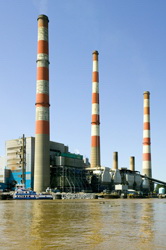On the tracks of mercury pollution
Methylmercury (MeHg) is formed from Hg2+ ion in waters. Hence, MeHg, a powerful neurotoxin, is a frequent component of polluted water. Concern for the environmental and health effects have prompted studies on both the methylation of Hg2+ and natural degradation (demethylation) of MeHg. The HG-197 MEHG Assess project has just completed research to trace Hg2+ in the field and in experimental setup to find out what conditions favour both the formation and degradation of the compound. Using the 197 Hg radiotracer, project scientists followed the path of Hg at the Reaktor Centre at the Institute Jozef Stefan in Slovenia. Recording Hg retention and the reduction capacity of Hg2+, the researchers evaluated tracer activity in the outgoing airflow and in bubbling water in the system. A second phase of the project recorded the Hg2+ retention of gypsum used in a flue gas desulphurisation (FGD) plant. FGD plants are notorious for mercury emissions and are commonly installed at coal-fired power plants. Hg retention was also measured in an FGD system using a potassium manganate (VII) (KMnO4) trap under different conditions of pH and reduction-oxidation (REDOX) control. To study the behaviour of Hg in the natural environment, water samples from a lake, river and coastal lagoon as well as from sea and rain water were spiked with Hg2+, traced with 197 Hg and stored in different conditions. Losses of Hg2+ were evaluated for each of the solutions. The HG-197 MEHG Assess project has fulfilled a rising need for the evaluation of mercury methylation in sea waters as opposed to sediment, an area frequently researched. The improved methodology for assessing Hg formation and degradation will be a valuable tool for use in lakes and coastal ecosystems.







